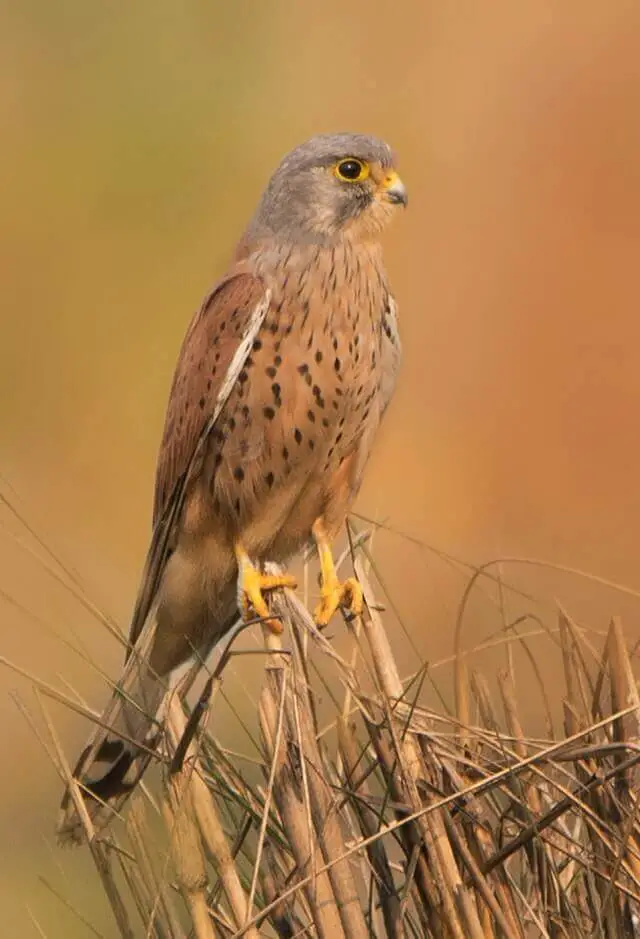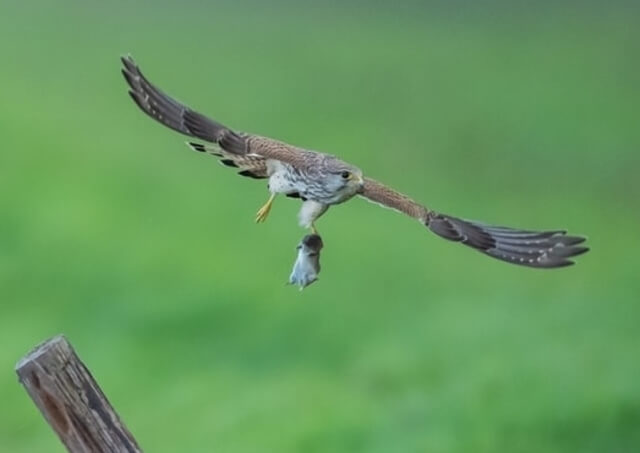Welcome to an exhilarating journey into the world of the Common Kestrel! Prepare to be captivated by 50 astonishing facts about these majestic birds of prey. From their remarkable hunting prowess to their enchanting aerial acrobatics, each fact will unveil the extraordinary nature of these fascinating creatures. Join us as we delve into the secrets of the Common Kestrel and gain a newfound appreciation for their place in the natural world. Let’s embark on this thrilling adventure of discovery together!
Table of Contents [show]
Common Kestrel (Overview)

Common Kestrel Facts
| Characteristics | Description |
|---|---|
| Identification | The Common Kestrel is a medium-sized falcon found throughout Northern and Western Eurasia. Both males and females share similar features. They have blue-gray feathers on the head and tail, with a chestnut brown plumage adorned with black spots on the back. The throat, breast, and belly exhibit a buff color with thin black streaks. Their beak is black and downward hooked, featuring a yellow cere, and they have yellow legs with black talons. |
| Adult Length | 13-15 inches (32-39 cm). |
| Adult Weight | Male: 135-253 g (4.8-8.9 oz), Female: 153-315 g (5.4-11.1 oz). |
| Wingspan | 25-35 inches (63.5-88.9 cm). |
| Taxonomy | Order: Falconiformes, Family: Falconidae, Genus: Falco, Species: F. tinnunculus, Binomial Name: Falco tinnunculus (Carl Linnaeus 1758), Scientific Name: Falco tinnunculus. |
| Range | Common Kestrels are predominantly found in North America and Europe, with a range spanning from Western Europe to Central Asia and Africa. |
| Migration | Most Kestrels are permanent residents, except for those residing in Northern latitudes. Northern populations migrate south during winter to warmer climates with more abundant food sources. |
| Habitat | Common kestrels are commonly found in open grasslands, farmlands, wetlands, marshes, tundra, taiga, shrubland, fields, and forested areas. |
| Diet | Their diet comprises insects such as cicadas, grasshoppers, beetles, fish, lizards, frogs, snakes, rabbits, squirrels, mice, voles, and small birds. |
| Global Population | Estimated 4,000,000-6,500,000 individuals. |
| Extent of Occurrence | Approximately 116,000,000 km2 (44,787,850.4 square miles). |
| Conservation Status | Listed as Least Concern, but the population is decreasing. |
| Breeding Period | In Eurasia: Late April or early May; In the Tropics & South Africa: August to December. |
| Incubation Length | 26-32 days. |
| Nestling Period | 28-31 days. |
| Clutch Size | 3-7 eggs. |
| Number of Broods | 1 Brood. |
| Nesting Spots | Common Kestrels are cavity nesters, often using holes in trees or cliffs. In urban environments, they may nest in man-made structures like buildings or bridges. They also reuse old woodpecker holes or abandoned crow nests. |
| Nesting Habits | The female scrapes a small depression in the nest and lays 3-6 speckled brown eggs. Incubation lasts 27-29 days, during which the male provides food. Newborn chicks have white downy feathers and fledge around four weeks, gradually exploring their surroundings. Adults continue feeding the chicks for about a month until they can catch their own food. |
- The Common Kestrel, a species of small falcons, is commonly found throughout North America.
- Kestrel chicks undergo rapid growth, reaching their full adult body size in approximately 20 days from hatching.
- The oldest recorded kestrel lived to an impressive age of nearly 24 years.
- Female kestrels have the capacity to lay one clutch of 3-7 eggs per year, a process that can take up to 11 days to complete.
- The proximity of a kestrel’s habitat to the nearest road can lead to a significant reduction in their lifespan, with a 50% decrease for every 100 meters closer.
- These birds face a range of predators, including coyotes, red-tailed hawks, golden eagles, large owls, and raccoons, posing threats to both adult and young kestrels.
- Kestrels are protected under the Migratory Birds Treaty Act, which strictly prohibits any harm or hunting of these birds.
- Kestrels exhibit strong territorial behavior, vigorously defending their nesting areas against intrusions by other kestrels of the same gender.
- Both male and female kestrels employ a high-pitched screech to actively deter intruders, aiming to intimidate potential threats.

- During hunting, the Common Kestrel gracefully soars at an altitude of approximately 12–25 meters (39–82 feet) above the ground, employing a rapid swooping technique known as a “stoop” to capture small prey from above.
- The Common Kestrel goes by various names, including Eurasian Kestrel, European Kestrel, and Old World Kestrel.
- Sexual dimorphism is evident in Common Kestrels, with females being significantly larger than males. On average, females have a 25% greater body mass and are over 50% heavier.
- The wingspan of the Common Kestrel spans from 25 to 35 inches (63-89 cm), and its weight ranges from 5 to 11 ounces (142-311 g).
- Kestrels are known for their lifelong monogamous mating system, where they choose a single partner for life. These pairs cooperate in nest building, incubating eggs, and feeding their offspring, boosting their reproductive success.
- Female Common Kestrels typically lay about three eggs per year, and the incubation period lasts approximately 28 days.
- Common Kestrels usually consume 4-8 voles daily, adjusting their intake based on seasonal and energy needs.
- These birds possess dual camouflage strategies: their feather coloration allows them to blend into their surroundings visually, and they can emit a distinct “kii-kii-kii” sound to deter potential predators.
- Common Kestrels are diurnal hunters, primarily targeting airborne insects, small mammals, and birds. Their diet comprises roughly 70% rodents, 20% birds, and 10% other animals, with no specific preference for species.
- Utilizing their exceptional eyesight, which is four times more potent than that of humans, Common Kestrels hunt from elevated perches during the day.
- While in the wild, Kestrels can reach a lifespan of up to 16 years, but the average lifespan typically hovers around 3 to 4 years.
Frequently Asked Questions
Do kestrels eat blackbirds?
Kestrels are versatile predators known for their varied diet, encompassing small mammals like rodents and hares, birds such as pigeons and songbirds, insects including grasshoppers and beetles, reptiles like snakes and lizards, as well as amphibians, such as frogs, and various invertebrates like snails and earthworms.
How fast can a kestrel dive?
Kestrels are highly proficient hunters when it comes to capturing prey on the ground. Their exceptional abilities are attributed to their long, razor-sharp talons and remarkable agility. With the capability to dive at astonishing speeds of up to 60 mph (96 km/h), they can swiftly seize unsuspecting birds or mice!
How fast can a Common Kestrel fly?
Common Kestrels are capable of reaching horizontal speeds of up to 40 mph (64.4 km/h) in brief bursts, though they cannot sustain this pace over extended periods. Typically, they employ a flight strategy involving gliding with the wind, skillfully navigating side-to-side to harness updrafts and thermals. Additionally, these birds can adeptly hover or soar, conserving energy as they patiently await passing prey.
How far can a kestrel see its prey?
The Kestrel possesses vision four times sharper than that of a human. From distances of up to 50 meters, these raptors can effortlessly spot their prey. This remarkable visual acuity comes into play when Kestrels are in flight over diverse landscapes, including grasslands, mountains, or forests, where prey might not be easily visible on the ground. Their exceptional eyesight extends to detecting even the subtlest movements of animals beneath them.
What are kestrels predators?
Kestrels face a range of predators, including formidable threats like peregrine falcons, northern goshawks, eagle owls, and sparrowhawks. However, not all of their adversaries possess the power of flight; creatures like raccoons, weasels, badgers, or foxes can still pose a threat to kestrels when they are strategically positioned.



